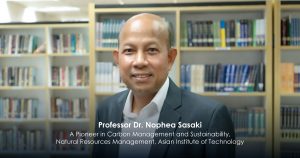17 Jun 2024
Urban green spaces are crucial for fostering community well-being, providing a place for social interactions and physical activity, which improves mental health and reduces symptoms of stress, anxiety, and depression (Gianfredi et al., 2021, Miao et al. 2023). Public parks and community gardens are excellent spaces for older adults to socialize and engage with their community. Moreover, they contribute to mitigating urban heat by providing green spaces that help cool the environment and enhance air quality. Unfortunately, Thailand faces challenges in providing ample space for such activities. Many residents of Bangkok must travel a considerable distance of 300-500 meters to access the nearest park due to limited availability. Additionally, green spaces are limited in Thailand, posing a challenge for urban residents seeking outdoor recreational opportunities.
“Bangkok’s rapid urbanization has drastically reduced its public green spaces, leaving the city with just 1.47 m2 green space per capita, far below the WHO recommendation of 9 m2,” said Dr. Nophea Sasaki, Professor of Natural Resources Management at the Asian Institute of Technology (AIT), who gave a talk on “Transforming Urban Spaces: Nature-based Solutions for Carbon Removal and Enhanced Urban Greenness,” at Sasin Research Seminar.
 Dr. Nophea suggested that Thailand applies Nature-based Solutions (NbS), which are strategic approaches that utilize natural processes and ecosystems to address societal challenges, such as climate change, water security, and biodiversity loss, by promoting sustainable and resilient environmental practices.
One of the ways Thailand can expand its green urban spaces is to apply innovative tree management, transforming trees into beautiful shapes and shrines. For example, Chulalongkorn University has many Ficus trees that can be manipulated into archways where people can take photos or build a coffee shop nearby. Dr. Nophea outlined four ways of applying Innovative Tree Management:
Dr. Nophea suggested that Thailand applies Nature-based Solutions (NbS), which are strategic approaches that utilize natural processes and ecosystems to address societal challenges, such as climate change, water security, and biodiversity loss, by promoting sustainable and resilient environmental practices.
One of the ways Thailand can expand its green urban spaces is to apply innovative tree management, transforming trees into beautiful shapes and shrines. For example, Chulalongkorn University has many Ficus trees that can be manipulated into archways where people can take photos or build a coffee shop nearby. Dr. Nophea outlined four ways of applying Innovative Tree Management:
 Dr. Nophea suggested that Thailand applies Nature-based Solutions (NbS), which are strategic approaches that utilize natural processes and ecosystems to address societal challenges, such as climate change, water security, and biodiversity loss, by promoting sustainable and resilient environmental practices.
One of the ways Thailand can expand its green urban spaces is to apply innovative tree management, transforming trees into beautiful shapes and shrines. For example, Chulalongkorn University has many Ficus trees that can be manipulated into archways where people can take photos or build a coffee shop nearby. Dr. Nophea outlined four ways of applying Innovative Tree Management:
Dr. Nophea suggested that Thailand applies Nature-based Solutions (NbS), which are strategic approaches that utilize natural processes and ecosystems to address societal challenges, such as climate change, water security, and biodiversity loss, by promoting sustainable and resilient environmental practices.
One of the ways Thailand can expand its green urban spaces is to apply innovative tree management, transforming trees into beautiful shapes and shrines. For example, Chulalongkorn University has many Ficus trees that can be manipulated into archways where people can take photos or build a coffee shop nearby. Dr. Nophea outlined four ways of applying Innovative Tree Management:
- Root Manipulation Techniques: Techniques such as aerial root grafting and selective breeding can be employed to shape the root structures of Ficus trees.
- Structural Uses: The malleable nature of Ficus aerial roots can be harnessed to form natural architectural elements like archways, swings, and benches.
- Engagement and Interaction: By transforming Ficus trees into interactive and engaging features, urban planners can create unique green spaces that attract more visitors and encourage public interaction with nature.
- Ecological Benefits: Beyond aesthetics, these innovative management practices can improve the ecological health of urban areas by increasing green cover and biodiversity, which in turn enhances the overall sustainability of the city.